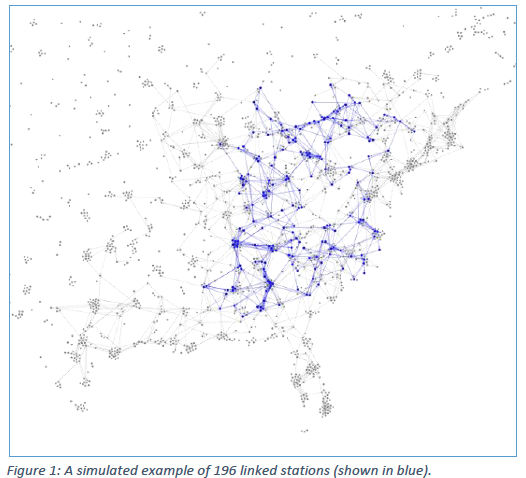UPDATED: FCC Proposes DMA-Level Phased Repack
WASHINGTON—The Federal Communications Commission has proposed a phased-in repack following the TV spectrum incentive auction. The transition will involve a market-by-market approach, concentrating on moving stations within individual designated market area in no more than two moves.
The post-auction transition will involve moving many TV station signals to new channels. The Transition Scheduling Plan Public Notice(TSPPN) is the staff's proposal for an orderly transition, it said. FCC officials emphasized that the TSPPN comprises a proposal and implored stakeholders to file comments. Those comments are due Oct. 31, (on MB Docket No. 16-306/GN Docket No. 12-268). Replies are due Nov. 17. The commission also said it would host a webinar on the TSPPN Oct. 13. (Editor’s Note: The commission has changed the date of the webinar to Monday, Oct. 17, from 1 to 4 p.m. Eastern to avoid conflicting with the IEEE Broadcast Technology Society’s Annual Broadcast Symposium is being held from Oct. 12 - 14. The webinar will be streamed live with open captioning over the Internet from the FCC’s web page atwww.fcc.gov/live. The webinar slides will be posted on the broadcast incentive auction website’s resources page prior to the start of the webinar. )
The TSPPN makes no mention of ATSC 3.0, the over-the-air transmission standard being compiled by the Advanced Television Systems Committee, and targeted for an early 2017 completion. Commission officials reiterated their intention of considering auction activities independently of the approval process for allowing broadcasting to adopt ATSC 3.0, an IP-based platform that would enable broadband-like connectivity.
The TSPPN outlines a 10-phase transition and announces that TV stations will receive confidential letters with their final channel assignments shortly after the final stage rule is satisfied so they can finalize equipment orders. Vendors will likely need a quick turn-around on this information to commence fabrication of transmitters and antennas, for example. The tool developed by the commission to determine when to move stations is said to anticipate vendor schedules.
This Phase Scheduling Tool, is said to take into account current manufacturer inventories, ordering, manufacturing and delivery times, as well as the time required for planning and zoning, legal work and pre-construction tower alterations, and coordination with other stations within a Designated Market Area. This Phase Scheduling Tool is described in the TSPPN at some length.
The question of 3.0 equipment remains unknown for the time being, but an FCC official did say that the Widelity Report, first published in 2014, would be updated to reflect 2016 prices very soon.
The proposal assigns each station into one of 10 transition phases with staggered completion dates to ease coordination issues and enable the commission to track progress. The dates all fall within the previously established 39-month deadline for all stations assigned to new channels to move from their current channels. But as the graphic below indicates, not all stations will have 39 months to make the switch. The earliest would have a little over a year to vacate their current channel in what the commission describes as the hypothetical schedule illustrated in the graphic below.

The phased approach is intended to protect broadcasters from undue interference throughout the transition. The proposal attempts to move stations residing in the new wireless band as early as possible to ensure forward auction winners have timely access to spectrum. The proposal intends to minimize impact on consumers by limiting the number of times over-the-air viewers will have to rescan for channels.
Those stations that must move to a new channel will have to modify their existing facilities — antennas, transmission lines—to transmit on a different frequency. Then they must test their equipment. Unless a station’s new channel is available, that is, free from interference caused by other stations, it will need to coordinate carefully with one or more other stations to prevent the testing from causing interference.
With hundreds of stations nationwide needing to move to new channels, there is the potential for a traffic jam in which a station can’t move to its new channel until a second station moves, and that station in turn must wait for a third station to move, and so on. Stations whose moves are dependent on another’s move are called “linked stations,” and these links can span dozens of stations across a large geographic area. Linked stations can switch to their new channels simultaneously to break up these congestion points, but doing so requires careful coordination.
In order to facilitate an orderly and timely transition, the staff proposes using a mathematical tool – the Phase Assignment Tool – that determines the order in which stations must transition to new channels. With hundreds of stations needing to move to new channels, there are millions of possible sequences, the commission said.
The TSPPN proposes a procedure for determining the optimal sequence by assigning stations to phases, by the end of which all stations within the phase must be off their pre-auction channels. The optimal sequence will meet a set of conditions, including:
Clear 600 MHz Wireless Band As Soon As Possible: Assigning U.S. stations whose pre-auction channels are in the 600 MHz Band to earlier phases would help open it up to licensees to offer new innovative services.
Limit TV Viewer Rescans/Preserve Regional Focus: Limiting stations in the same Designated Market Area to two phases also limits to two the number of times viewers would need to rescan for over-the-air channels. It also reflects the regional approach that stakeholders have suggested.
Give “Complicated” Stations More Time: Assigning the most challenging and time-consuming stations (as defined in the Widelity Report) to later phases allows adequate time for their transitions.
Limit Linked Station Sets in a Phase: Limiting linked sets within a phase would limit the effect of dependencies and facilitate coordination among broadcasters.
Limit the Total Number of Phases to 10: Using 10 phases strikes a balance between limiting the size of linked-station sets and other goals. A greater number of phases could decrease the number of linked-station sets in each phase but makes more difficult other goals such as transitioning stations within the same DMA at the same time and avoiding the need for multiple channel rescans by viewers. Keeping the number of stations in each phase roughly equal also helps in the sharing of resources in each phase.
No More than 2 Percent Temporary Interference: Allowing temporary limited increases in interference between two stations is in accord with past transitions and would significantly reduce the number and complexity of dependencies.
No Temporary Channels: Using a temporary channel during the transition could reduce the size of linked-station sets but would also add costs, strain resources, and add more rescans for viewers.
Once stations are assigned to phases, the commission will determine whenthose stations switch to their new channels with the Phase Scheduling Tool.
Specifically, the tool:
- Assigns minimum completion times for each station based on certain characteristics.
- Allows the FCC to assess the impact of unknowns such as the order in which stations receive required resources.
- Gives the FCC the ability to gauge the impact of resource availability and adjust accordingly.
The TSPPN proposal details the specific tasks or processes proposed to be modeled for each of the stages of the transition process, as well as the estimated time and resource availability for each task.
Putting stations into different phases with a detailed schedule will let stations, tower crews, and equipment manufacturers know when the FCC expects specific stations to complete their transition and so that they can plan accordingly, the commission said. It also intends ensures that the majority of stations will be able to test on their post-auction channel during a specified testing period without having to coordinate with neighboring stations—or those stations’ neighbors.
Also see our Spectrum Auction silo for more coverage.

The professional video industry's #1 source for news, trends and product and tech information. Sign up below.
